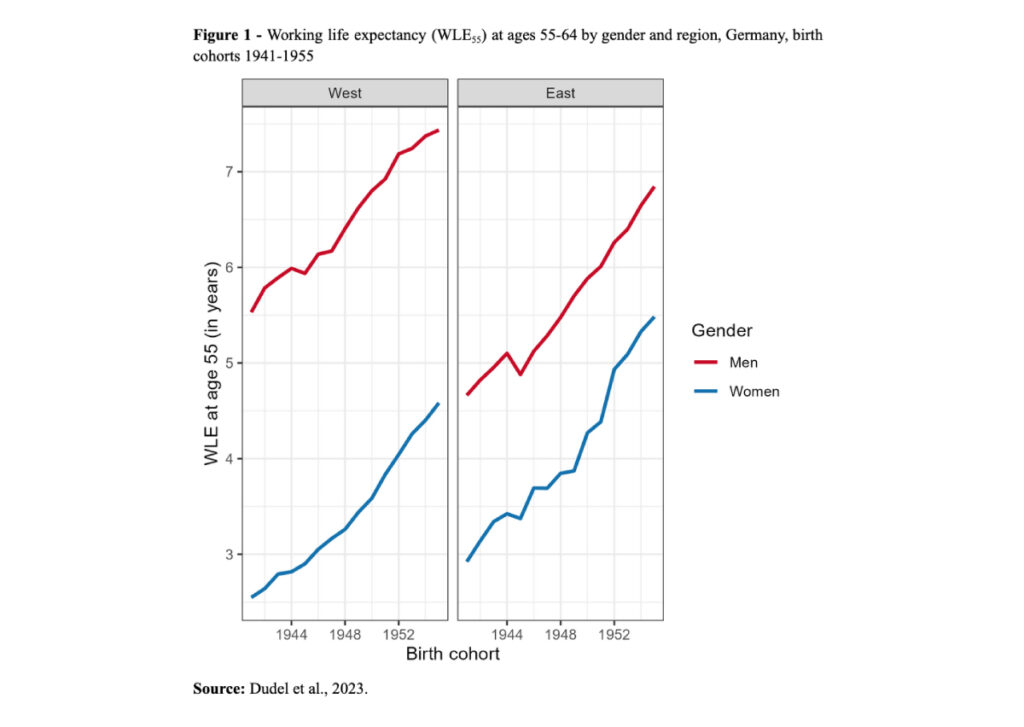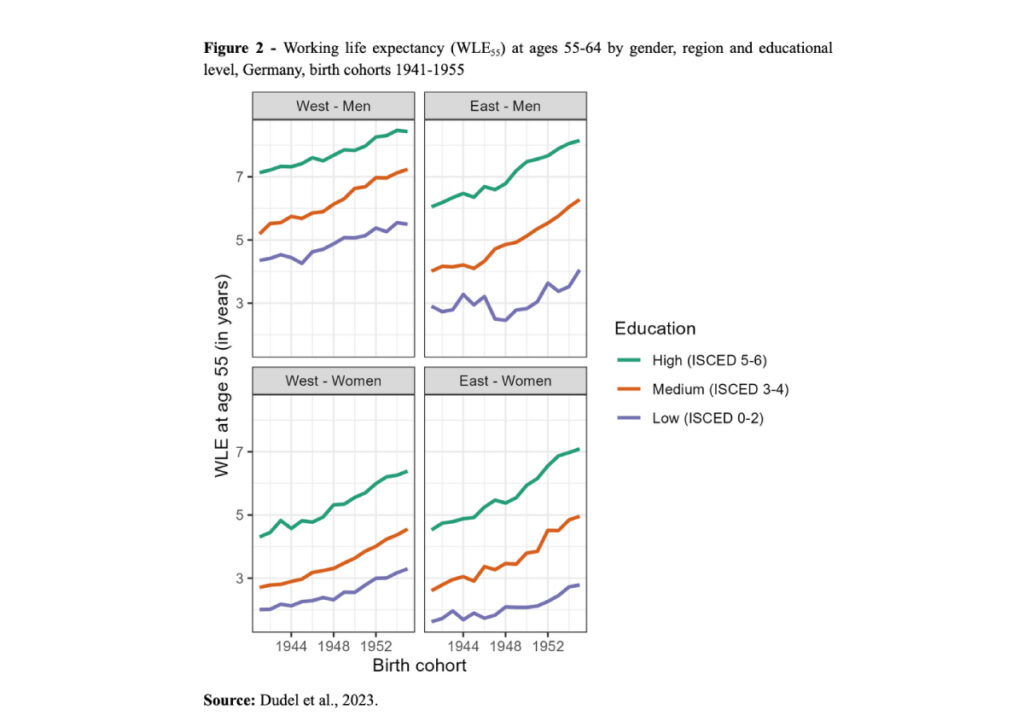
Rapid population aging may undermine the viability of the German pension system. Is working longer a remedy? Christian Dudel, Elke Loichinger, Sebastian Klüsener, Harun Sulak, Mikko Myrskylä analyse what is known about employment in later adult life in Germany. Employment trends are on the increase, but with considerable socioeconomic differences.
Germany is aging
The German population is among the oldest in the world and is aging rapidly. Projections of the German Federal Statistical Office (Statistisches Bundesamt, 2022) indicate that in 2050 around 26% of the population will be over age 67, which will be the statutory retirement age by 2031. As the number of retirees increases and the workforce shrinks (Fuchs et al. 2018), this rapid population aging will be a challenge for the German social security system, and for the German pension system in particular.
Extending the length of working life has been proposed as a remedy, as it increases the size of the workforce while reducing the number of retirees. Several institutions, such as the European Commission and the OECD, have been advocating for this shift (e.g., European Commission, 2010; OECD 2015). Meanwhile, many countries, including Germany, have implemented reforms with the major goal of prolonging working life. For instance, the statutory retirement age in Germany is currently being increased from 65 to 67.
Inequalities in the length of working life
Policies aimed at extending working life often follow a one-size-fits-all approach. As these policies are frequently applied with few or no exceptions, or are aimed at workers in stable employment (e.g., Phillipson 2019), they might have negative effects on more economically insecure and vulnerable groups. For instance, increasing the retirement age for almost everyone, as is currently the case in Germany, may increase the duration of working life for highly educated men with high employment rates, while low educated individuals face a high risk of unemployment during the additional years they are forced to stay in the labor market.
A series of studies in several countries have revealed substantial socioeconomic inequalities in the length of working life (e.g., Dudel & Myrskylä 2017). In a recent paper (Dudel et al. 2023), we provide new evidence of such inequalities for older workers in Germany, and focus on several dimensions of inequality: gender, occupation, education, and region (distinguishing between the former socialist eastern Germany and western Germany). Below we provide an overview of some of the key findings, focusing on general trends and inequalities by education.
General trends in Germany
Our key indicator is working life expectancy (WLE55), defined as the average remaining lifetime spent in work. It is measured in years and, for our study, we computed it between ages 55 and 64, adjusting it for working hours. This means that our results are based not only on whether individuals are or are not gainfully employed, but also on whether they are working full- or part-time. We used data from the German Microcensus for the years 1996 to 2019, and calculated WLE55 for the cohorts born between 1941 and 1955 (Fig. 1).

For instance, the number of additional years western German men could expect to remain employed at age 55 rose from 5.5 years for those born in 1941 to 7.4 years for those born in 1955. For all groups, WLE55 increased by around 2.0 to 2.5 years over the observed birth cohorts. This shift is likely attributable to several factors, including pension reforms aimed at extending working life and better health among younger cohorts.
In both western and eastern Germany, men worked for longer than women. However, the gender gap was always smaller in the east than in the west, and it decreased somewhat in eastern Germany, while remaining roughly constant in western Germany. Similarly, eastern German women worked longer than their western German counterparts. Among men, by contrast, the opposite pattern is observed, with western German men working longer. These regional and gender differences are legacies of eastern Germany’s socialist past and the unification process. When the east was socialist, policies aimed at integrating women into the labor market led to higher female employment rates in eastern Germany than in the west. This pattern continued after German unification, even during periods when unemployment rates in eastern Germany were high.
Educational inequalities in Germany
Employment in late adult life depends also on education, for which, in our paper, we considered three levels:
• low (equivalent to ISCED levels 0 to 2),• medium (ISCED levels 3 to 4), and• high (ISCED levels 5 to 6).
Results are displayed in Figure 2. When interpreting them, it is important to keep in mind that the lowest educational group is smaller and more selective in eastern than in western Germany, as less than 10% of the population aged 55 to 64 in eastern Germany have low educational attainment.

On average, WLE55 increased for all educational groups, but with considerable heterogeneity in both level and pace. For instance, beyond age 55, low-educated eastern German women worked, on average, only three additional years, while highly educated western German men worked almost nine. Moreover, in eastern Germany, the increase in WLE55 was notably smaller for low-educated individuals than for the other educational groups. For example, the gap between highly educated and low-educated eastern German men increased from roughly three to four years.
Conclusions
In summary, the length of late working life has been steadily increasing in Germany for all the socioeconomic groups we considered. This trend is in line with the aim of many recent policy reforms to increase retirement age. However, our findings show that there are substantial and increasing socioeconomic inequalities in the length of working life after age 55 among older workers. Researchers and policymakers should focus more on these inequalities, as they might be outcomes of systematic social disadvantages among specific groups of older workers. To help us better understand inequalities in WLE55, we are currently extending our calculations of WLE to cover all working ages. If, for instance, low-educated workers start working at earlier ages than highly educated workers, inequalities in total WLE might be smaller than inequalities in just WLE55, i.e. among older workers only.
References
- Dudel, C., Myrskylä, M. (2017): Working Life Expectancy at Age 50 in the US and the Impact of the Great Recession. Demography 54: 2101-2123.
- Dudel, C., Loichinger, E., Klüsener, S., Sulak, H., Myrskylä, M. (2023): The extension of late working life in Germany: trends, inequalities, and the East-West divide. Demography. https://doi.org/10.1215/00703370-10850040
- European Commission (2010): Annual growth survey: Advancing the EU’s comprehensive response to the crisis.
- Fuchs J., Söhnlein D., Weber B., Weber E. (2018). Stochastic forecasting of labor supply and population: an integrated model. Population Research and Policy Review, 37, 33-58.
- OECD. (2015): Pensions at a glance 2015. Available at OCED.
- Phillipson C. (2019). “Fuller” or “extended” working lives? Critical perspectives on changing transitions from work to retirement. Ageing & Society, 39, 629-650.
- Statistisches Bundesamt, 2022: 15. koordinierte Bevölkerungsvorausberechnung – Deutschland. Available online.
No comments:
Post a Comment